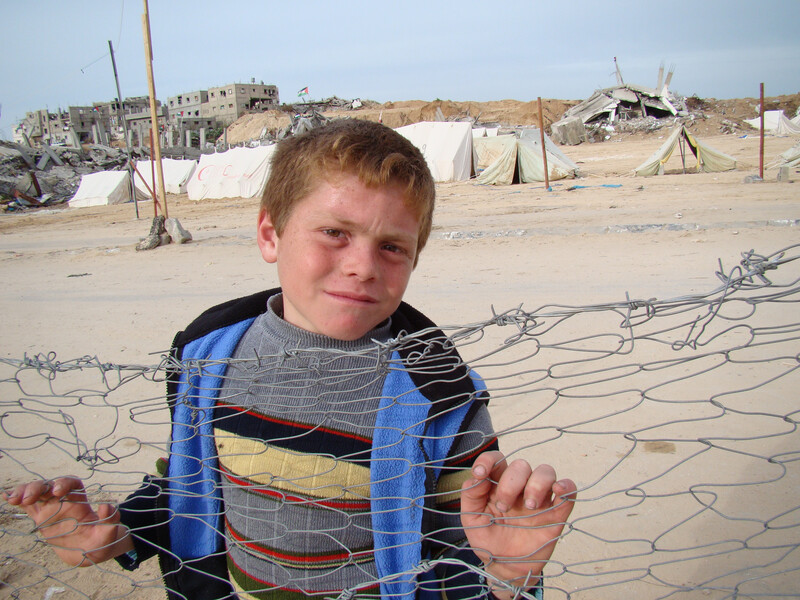The Electronic Intifada 6 June 2013

Where Should the Birds Fly shows the everyday injustices faced in Gaza.
Where Should the Birds Fly, the new documentary directed and narrated by Fida Qishta, begins with chilling footage of Israeli bulldozers destroying houses in Rafah in 2004. Qishta, a native of Rafah, the city in the south of the Gaza Strip, watched her parents’ house of 30 years crumble under the bulldozers. As it was destroyed, her father told her and her family to leave and keep walking. “He feared if our eyes took in the sight, our hearts would be filled with hate,” Qishta says.
The young woman channeled the intense anger and frustration felt from this episode, and many others caused by the Israeli blockade, to create a touching film that reveals many of the daily injustices in Gaza.
Qishta began her career as a wedding videographer. After becoming comfortable with the camera, she began to film her surroundings and eventually accompanied human rights observers to document their work.
Much of the first half of the film features scenes of everyday life for Palestinians in Gaza. Qishta left the Gaza Strip in 2006 to visit Europe; when she returned she was forced to wait for three weeks at the border. She filmed the time she spent waiting to re-enter her home.
Shots of the border crossing terminal show tired men, women and children as they waited indefinitely without being offered beds or food.
Targeted by snipers
The documentary visits the farming village of Khozaa, which lies in the Israeli-designated “buffer zone,” land near the boundary with Israel that Palestinians are forbidden from entering. The land, once fertile farmland, is frequently targeted by Israeli sniper fire when farmers attempt to tend it.
The documentary follows farmers as they are accompanied by international activists and try to work the land. Included in this scene is footage of International Solidarity Movement volunteer Vittorio Arrigoni, who dedicated much of his life to working in Gaza and was murdered there in 2011.
Arrigoni stands up against the faraway Israeli soldiers who are shooting at the farmers and yells into a bullhorn, “Stop shooting. We are unarmed.” The shooting continues.
The second half of the film is mostly dedicated to the 2008-2009 Israeli offensive against Gaza. Qishta says, “They called [the offensive] Operation Cast Lead, but we call it a massacre.” The 22-day attack left approximately 1,400 Palestinians and 13 Israelis dead.
Qishta was one of the first journalists on the scene of the first shellings, filming the destruction against her family’s advice. The footage of the chaos and devastation under constant Israeli attack is shocking.
“My only weapon”
Qishta’s camera captures women and children as they run for their lives through smoke-filled streets. A young boy stops and looks at the mangled body of a man on the sidewalk. A mother hysterically cries as she looks for her son. White phosphorous rains from the sky in unending streams.
Qishta describes how she saw fear in everyone’s eyes, but couldn’t leave or stop filming. “My camera is the only weapon I had against these attacks on the people of Gaza.”
Perhaps the most affecting character of the film is 10-year-old Mona Samouni. The girl was hiding in one house with nearly 100 members of her family during the bombardment, when it was hit by Israeli fire. Twenty-one members of her family were killed in front of her, including her mother and father.
The film first shows Mona shortly after the attacks as she walks through rubble with a large bandage over one eye. Qishta asks her to wait, and she turns to look at the camera with somewhat poised indifference.
She is wearing a matching hat and scarf and a pink purse. Qishta asks her how many people were killed in her family. “My immediate family?” she answers. “Not many, just my mother, my father, both my sisters-in-law and my nephew.”
Chilling
In several interviews, the young girl describes chilling accounts of the attack that killed her parents. She speaks with little emotion but makes statements far beyond her age. As she displays for the camera drawings of her family’s house being attacked, she says, “for the Israeli army, this is something without meaning. But the victims were very precious to us.”
Scenes like this foster a deep probing of the inhumanity of the military attacks and ongoing blockade of Gaza, where Palestinians live in an open-air prison and cannot flee from attacks. The film reveals how the blockade deliberately intends to create a miserable and unlivable existence for the Palestinians in Gaza.
In another example of this, Qishta accompanies a fishing expedition off the coast of Gaza, and while at sea the boat is repeatedly fired at and ordered to leave while the fishermen attempt to work. The cords that tether the net in the water to the boat are shot and broken so that all of the fish are lost. Qishta asks, “Do they consciously intend to deprive [the fishermen] of the ability to make a living and feed their families?”
Fida Qishta’s years in Gaza and her connection to the land and the people make this film a great success. She visits and revisits Khozaa to see her friends after one is struck by white phosphorous weaponry, filming a touching interview with the victim.
She follows and befriends Mona Samouni and her surviving family, weaving together their stories. She elicits touching interviews from farmers and fisherman as they work in dire conditions.
Her brave documentation of injustice on Palestinian land and sea paints a moving picture of life in the Gaza Strip.
For more information about the film, visit whereshouldthebirdsfly.org
Daryl Meador is a recent graduate of the School of the Art Institute of Chicago who recently lived and volunteered in Nablus.




